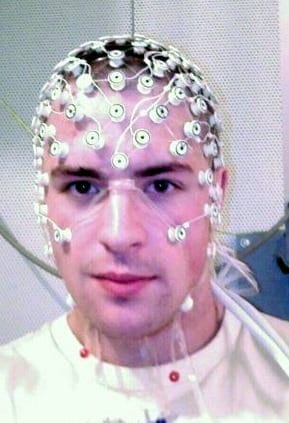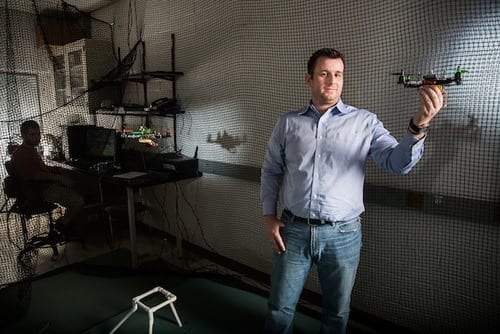
Innovation is all about putting on the proverbial thinking cap.
Now engineers are vying to produce an actual thinking cap – at least one that can measure the most rudimentary signals of thought. The US Department of Defense is pushing for the development of cheap, wearable systems that can detect the brain waves of people and display the data on smartphones or tablets.
This past spring, the DOD awarded four companies design grants through the Small Business Innovation Research (SBIR) program, which is designed to spur the development of technologies not already available in the commercial market. A Phase I grant in the amount of $100,000 has been awarded, with those entities competing for a possible Phase II grant that could total $750,000 or more.
The Pentagon has called for the development of a small, low-cost device (perhaps as cheap as $30) to measure electroencephalography, the voltage fluctuations that occur as neurons fire within the brain. The device would work in conjunction with an app to deliver real-time information on neural activity to a tablet or smartphone.
While EEG readings are most often used to provide data on those with head injuries or who suffer seizures, the DOD notes that more recently EEG has been explored commercially in “neuro-marketing” and to provide neuro-feedback via brain-computer interfaces, allowing people to move objects or play computer games with their mind.
While an array of technologies can give indications of brain activity, EEG offers several advantages – mainly portability and cost. But the technology has several hurdles, including the knotty problem of trying to get an accurate reading of tiny impulses in the brain even as bone, scalp and hair muddle the reception.
In the near term, the DOD sees cheap EEG devices being included in field first-aid kits to provide near-instantaneous analysis of an injured soldier’s brain activity.
“For instance, if somebody was exposed to a blast and an individual goes out who is the medic, … within his kit he has this EEG system folded up,” says Brent Winslow, lead scientist at Design Interactive in Oviedo, Florida, which is working on the SBIR grant. “The individual just wears this unit for two to five minutes and you are able to assess quantitatively the presence of an injury.”
While there are limits to what level of “thinking” such a cap can detect, an accurate, affordable and portable EEG system could open up other applications.
Go deeper with Bing News on:
Portable brain-reading device
- Most brain monitors sold to consumers don't keep your data private
A report found data privacy problems with the vast majority of 30 companies that sell neurotechnology devices to consumers. New US state laws aim to change that ...
- Reflecting back on 45 years of personal experience with science, technology, engineering, and math (STEM)
Ihave been feeling nostalgic lately. Several things going on in my life have me reflecting upon the past and thinking about the future – especially as it relates to my ...
- neuroClues wants to put high speed eye tracking tech in the doctor's office
The eyes aren't just a window into the soul; tracking saccades can help doctors pick up a range of brain health issues. It wants to make it easier for healthcare service providers to use eye tracking ...
- Music Is More Than Just Sound
SFMOMA explores the galaxy of visual and technological design that has long revolved around the music we love.
- Best Weed Pens of 2024: 6 THC Dab Pens for Relaxation
So nice and portable!” The Wedding Cake Weed pen is a disposable vaping device that offers a balanced combination ... Prioritize purchasing weed vapes from reputable and trustworthy brands. Read ...
Go deeper with Google Headlines on:
Portable brain-reading device
[google_news title=”” keyword=”Portable brain-reading device” num_posts=”5″ blurb_length=”0″ show_thumb=”left”]
Go deeper with Bing News on:
Brain-computer interfaces
- Dutch startup to test hearing via brain-computer interface
MindAffect has raised new funding for its hearing diagnostics solution that uses brain-computer interface technology.
- Tether Acquires Stake in Brain-Computer-Interface Firm Blackrock Neurotech
Tether, which claims to be one of the largest companies in the digital asset industry, announced that it has made a strategic investment.
- Stablecoin Giant Tether Pours $200,000,000 Into New ‘Brain-Computer-Interface’ Company BlackRock Neurotech
The firm behind the top US dollar-pegged stablecoin by market cap is investing hundreds of millions of dollars in a "brain-computer-interface" (BCI) company.
- Stablecoin issuer Tether invests US$200 million in brain-computer interface company
TETHER Holdings, the issuer of the biggest stablecoin, said it invested US$200 million in Blackrock Neurotech, a maker of brain-computer interface technology. Read more at The Business Times.
- Stablecoin Issuer Tether Invests $200 Million in Brain-Computer Interface Company
Tether Holdings Ltd., the issuer of the biggest stablecoin, said it invested $200 million in Blackrock Neurotech, a maker of brain-computer interface technology.
Go deeper with Google Headlines on:
Brain-computer interfaces
[google_news title=”” keyword=”brain-computer interfaces” num_posts=”5″ blurb_length=”0″ show_thumb=”left”]










